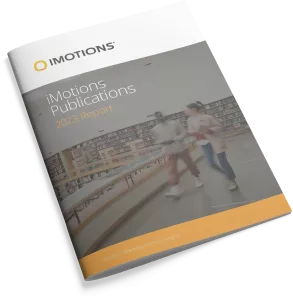-
A Sound Prediction: EEG-Based Neural Synchrony Predicts Online Music Streams
Neuroforecasting predicts population-wide choices based on neural data of individuals and can be used, for example, in neuromarketing to estimate campaign successes. To deliver true value, the brain activity metrics should deliver predictive value above and beyond traditional stated preferences. Evidence from movie trailer research has proposed neural synchrony, which compares the similarity of brain […] -
Viewing Natural vs. Urban Images and Emotional Facial Expressions: An Exploratory Study
There is a large body of evidence that exposure to simulated natural scenes has positive effects on emotions and reduces stress. Some studies have used self-reported assessments, and others have used physiological measures or combined self-reports with physiological measures; however, analysis of facial emotional expression has rarely been assessed. In the present study, participant facial […] -
Methodological Considerations for Understanding Students’ Problem Solving Processes and Affective Trajectories During Game-Based Learning: A Data Fusion Approach
This paper describes methodological considerations for fusing data sources in understanding both affective and problem solving states of students as they engage in computational thinking (CT) game-based learning. We provide both a theoretical and empirical rationale for using data including facial recognition and students’ logfile data to gain a more robust explanation of why students […] -
Situation Awareness Assessment for Ship Navigation Tasks in Virtual Reality Simulation System
This paper discusses whether the ergonomic assessment of the man-machine interface of the ship console in virtual reality simulation system can achieve the effect similar to that in physical simulation system. The similarity of the two systems was verified by assessing the situation awareness level of the subjects. 9 subjects were recruited to participate in […] -
An Analysis of Subliminal Static Images and Words Using Eye Tracking Techniques
This research used a Phenomenography approach of Eye Tracking to study the Biometric changes when participants were subjected to eight static subliminal images hidden in seven differently designed packages. Embeds or static subliminal stimulus in the form of pictures and words were hidden in seven different perfume packages and were used to study the changes […] -
Machine data as the source of learning engagement in hands-on learning online
Instructional technology provides the capacity to address the needs of students with diverse cognitive skills and socialization needs. Learning experience is viewed as an important factor in learner engagement/motivation, and a contributor to learning in online instruction (Sims, 2003; Swartzwelder & Murphy, 2019; Chan, Wan & Ko, 2019). Moore’s three types of learning interaction (Moore, […] -
Political leadership, a quasi-experimental study of Peruvian voters’ emotional reaction and visual attention to political humor
Political humor is a wise communicative strategy for politicians to use. However, previous research has not linked politicians’ use of political humor with voter’s emotional reactions and visual attention. Two experiments were conducted using facial expression analysis and eye-tracking technology to record the emotional reaction and visual attention of participants while watching one of the […] -
Detection of Psychopathic Traits in Emotional Faces
When meeting someone at zero acquaintance, we make assumptions about each other that encompass emotional states, personality traits, and even cognitive abilities. Evidence suggests individuals can accurately detect psychopathic personality traits in strangers based on short video clips or photographs of faces. We present an in-depth examination of this ability. In two studies, we investigated […] -
Affective Computing in Space Design
Architecture Digital Platforms are capable of creating buildings that provide comfort that meets human thermal, acoustic and visual needs. However, some building technologies can choose the physical energy arena of the building on the expense of the mentioned aspects of human comfort. Nevertheless, aspects like emotional and psychological human comfort exist in limited studies practiced […] -
Mapping of 3D Eye Tracking in Urban Outdoor Environments
New geospatial technologies and ubiquitous sensing allow new insights into people’s spatial practices and experiences of public spaces. These tools offer new data streams for analysis and interpretation of social phenomena. Mobile augmented reality tools such as smartphones and wearables merge the experience of entangled online and offline spaces in citizen’s daily life. This paper […]
Research Report 2024
In-depth look at the scientific landscape as powered by iMotions software, showcasing groundbreaking research and the impact of our tools in various scientific and industrial fields.

iMotions Science Resources
Looking for white papers, validation reports or research show casing iMotions Multimodal capabilities?
Share Your Research

850+ universities worldwide with an iMotions human behavior lab
73 of the top 100 highest ranked universities
710+ published research papers using iMotions
iMotions is used for some of the most interesting human behavior research studies carried out by top researchers around the world. Contact us to have your publication featured here.
The authors of these publications have used iMotions as a software tool within their research.
“Software should be cited on the same basis as any other research product such as a paper or a book; that is, authors should cite the appropriate set of software products just as they cite the appropriate set of papers” (Katz et al., 2020).
We therefore encourage you to cite the use of iMotions where appropriate.
How to cite iMotions
APA
iMotions (10), iMotions A/S, Copenhagen, Denmark, (2024).
Note: adjust the version and year where relevant.
5 Most Popular Blogs
Publications
Read publications made possible with iMotions
Blog
Get inspired and learn more from our expert content writers
Newsletter
A monthly close up of latest product and research news


